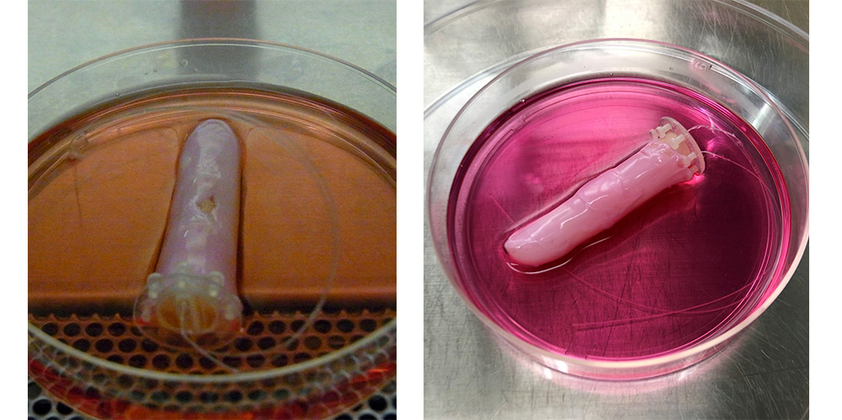J-STORIES - It’s not quite Blade Runner yet, but scientists at a Japanese university may have brought the world one step closer to a future of genetically engineered humans.
Researchers at the University of Tokyo have successfully coated a robot finger with a flexible layer of human-like skin grown in a lab. Because the skin is moist and supple, it isn’t damaged when the robotic digit bends. And if the skin is cut with a scalpel, it can be “healed” in a week by applying a collagen sheet, a little like covering a wound with an adhesive bandage.
The project was led by Professor Shoji Takeuchi of the University of Tokyo's Graduate School of Information Science and Technology and Ph.D student Michio Kawai, who published the results of their research in the online edition of Matter on June 9.
.jpg)
This is the first time that lab-grown skin has been applied to a 3D form such as a robot – in this case a finger with three joints. The skin is 1.5mm thick and has outer and inner layers corresponding to the epidermis and dermis of human skin. It has a soft and moist appearance, quite different to the silicon that has been used to coat humanoid robots to date.
When grown in the lab, dermal cells contract dramatically. The team took advantage of this property to grow a snug-fitting dermis layer over the finger that could still stretch when the finger flexed. They then sprinkled epidermal cells on top and cultured these to create the outer layer.

Speaking at a press conference, Takeuchi said the team hopes to extend the function of the skin by adding elements such as nerves, or blood vessels. They also hope to connect the skin to biological structures such as muscles, leading to more realistic movements.
Takeuchi’s other research includes bio-hybrid robots that can self-heal and reproduce. He has also worked on bio-hybrid robots that can smell and taste the same way as living creatures.
Other possible uses for the most recent technology include prosthetic limbs covered in realistic skin, 3D devices for testing cosmetics on lab-grown human skin, and real leather produced without the need to kill animals.
Translation and Editing by Tony McNicol
Top page photo by wenty20photos / Envato
For inquires about this article, please contact us at jstories@pacificbridge.jp
***
***
Click here for the Japanese version of the article.

![[Podcast] Japanese technology to supercharge human fertility (Part 4)](https://storage.googleapis.com/jstories-cms.appspot.com/images/1768443226894unnamed-5_smallthumbnail.jpg)

![[Podcast] Japanese technology to supercharge human fertility (Part 3)](https://storage.googleapis.com/jstories-cms.appspot.com/images/1766558713084place-for-scientific-research-2025-03-07-14-08-49-utc%20(1)_smallthumbnail.jpeg)
![[Podcast] Japanese technology to supercharge human fertility (Part 2)](https://storage.googleapis.com/jstories-cms.appspot.com/images/1765863548035unnamed-7_smallthumbnail.jpg)
![[Podcast] Japanese technology to supercharge human fertility (Part 4)](https://storage.googleapis.com/jstories-cms.appspot.com/images/1768443226894unnamed-5_bigthumbnail.jpg)

![[Podcast] Japanese technology to supercharge human fertility (Part 3)](https://storage.googleapis.com/jstories-cms.appspot.com/images/1766558713084place-for-scientific-research-2025-03-07-14-08-49-utc%20(1)_bigthumbnail.jpeg)
![[Interview: Part 2] A digital approach to tackle child hunger in Japan with dignity](https://storage.googleapis.com/jstories-cms.appspot.com/images/1766130666509unnamed_bigthumbnail.jpg)
![[Podcast] Japanese technology to supercharge human fertility (Part 2)](https://storage.googleapis.com/jstories-cms.appspot.com/images/1765863548035unnamed-7_bigthumbnail.jpg)
![[Podcast] Japanese technology to supercharge human fertility (Part 1)](https://storage.googleapis.com/jstories-cms.appspot.com/images/1765440905082unnamed_bigthumbnail.jpg)
_bigthumbnail.jpeg)



![[Interview] When digital and physical worlds meet](https://storage.googleapis.com/jstories-cms.appspot.com/images/1747974430456unnamed-2_smallthumbnail.png)

![[Interview] How Japanese musician Grover turned his passion of ‘sound’ into a health-tech startup](https://storage.googleapis.com/jstories-cms.appspot.com/images/1746181078493R7__1407_smallthumbnail.jpg)


_smallthumbnail.jpeg)

![[Interview: Part 1] From nourishing souls to feeding the hungry](https://storage.googleapis.com/jstories-cms.appspot.com/images/1763695595492unnamed_smallthumbnail.jpg)

